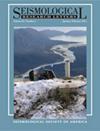利用W相位和提示弹性重力信号表征大地震的早期震源
IF 3.2
3区 地球科学
Q2 GEOCHEMISTRY & GEOPHYSICS
引用次数: 0
摘要
在大地震发生后的几分钟内,可以从局部距离的全波场记录或区域宽带地震仪记录的早期信号中获得地震破裂的可靠特征。我们将重点研究后一种结构,并评估早期低频弹性相位(W相位)和最近发现的提示弹性重力信号(PEGS)的单独和联合性能。2011年日本东北大地震是本次评估的自然目标,因为高质量的全球和区域网络能够收集到迄今为止最好的PEGS数据集。我们首先证实,使用全球地震台网记录的成熟的w相位方法能够在地震发生时间22分钟后提供可靠的质心矩张量解。使用区域站,可以更快地获得准确的w相溶液,在起始时间后可低至10分钟。另一方面,基于peg的震源反演可以提供更早的地震矩下限(Mw 8.6)和震源机制类型的约束,从震源时间后3分钟开始。然而,仅仅依靠PEGS会引入不确定性,这些不确定性是由地震噪声和震源参数之间的权衡所引起的,从而限制了震源确定的准确性。我们表明,即使将几个早期W相位信号合并到PEGS数据集也可以减少这些不确定性。使用更完整的W相位和PEGS数据集,在起始时间后5分钟,可以收敛到接近全局质心矩张量解的结果。本文章由计算机程序翻译,如有差异,请以英文原文为准。
Early Source Characterization of Large Earthquakes Using W Phase and Prompt Elastogravity Signals
Abstract In the minutes following a large earthquake, robust characterization of the seismic rupture can be obtained from full wavefield records at local distances or from early signals recorded by regional broadband seismometers. We focus here on the latter configuration, and evaluate the individual and joint performances of the early low-frequency elastic phases (W phase) and the recently discovered prompt elastogravity signals (PEGS). The 2011 Mw 9.1 Tohoku–Oki earthquake is a natural target for this evaluation, because the high quality of global and regional networks enabled to gather the best PEGS data set so far. We first confirm that the well-established W-phase method, using records from global seismological networks, is able to provide a reliable centroid moment tensor solution 22 min after the earthquake origin time. Using regional stations, an accurate W-phase solution can be obtained more rapidly, down to 10 min after origin time. On the other hand, a PEGS-based source inversion can provide even earlier, starting 3 min after origin time, a lower bound of the seismic moment (Mw 8.6) and constraints on the focal mechanism type. However, relying solely on PEGS introduces uncertainties caused by the hindering seismic noise and trade-offs between source parameters that limit the accuracy of source determination. We show that incorporating even a few early W phase signals to the PEGS data set reduces these uncertainties. Using more complete W phase and PEGS data sets available 5 min after origin time enables to converge towards a result close to the Global Centroid Moment Tensor solution.
求助全文
通过发布文献求助,成功后即可免费获取论文全文。
去求助
来源期刊

Seismological Research Letters
地学-地球化学与地球物理
CiteScore
6.60
自引率
12.10%
发文量
239
审稿时长
3 months
期刊介绍:
Information not localized
 求助内容:
求助内容: 应助结果提醒方式:
应助结果提醒方式:


